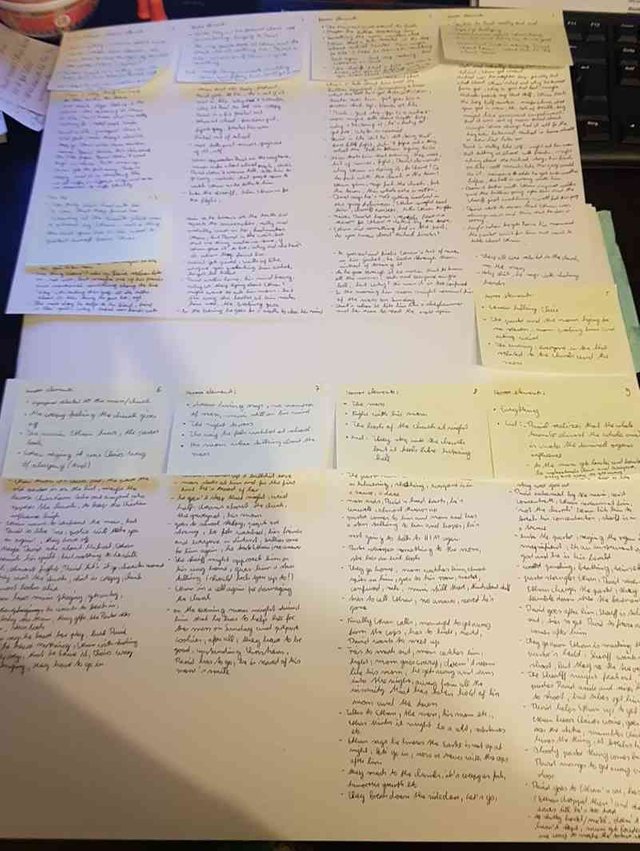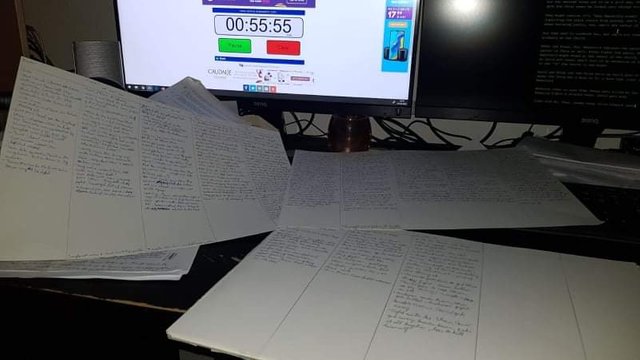Last year I’ve written a long series that I posted here on Steemit and on other places online. It’s a series that’s very dear to me and that I enjoyed writing very much.
Earlier this year, I decided that it was finally time to turn this series into a novel. I decided that it might interest someone here to share the process and to give some insight.
A bit about myself.
I’ve been writing seriously for almost three years now. In that time, I’ve written well over a hundred short stories. I wrote before, to be honest I’ve written for most of my life, but I was never serious about it and never wrote a lot.
As I said, I’ve mostly written short stories. The reason is simple: Writing a good short story is much easier than writing a good novel.
What I wanted wasn’t to write outstanding content, or to sell to paying markets. What I wanted was to become a better writer and to learn the craft. That’s why I chose short stories. You can write, edit and polish a short story in a week, maybe even a few days. So that’s what I did, writing one story a week for over two years. It was a slow but steady process, but I feel I improved tremendously.
While I’d written longer works before, I’d shied away from anything exceeding 10.000 words for a long time.
Last year I finally decided that it was time to start writing longer works. Well, I didn’t simply decide, I just found myself with a story that kept growing and growing and growing. And of course, I’d always wanted to write longer works, like novellas and novels, I just didn’t think I was ready.
The first longer work I wrote was a series titled ‘Laura Ebert’. It’s the story of a young girl who tries to unravel the mystery of the local village’s crazy woman by the titular name.
Now, I don’t think it’s a bad story. I enjoyed writing it and I think the plot and the general story is great and many people enjoyed following our narrator unraveling the mystery. Still, the story itself felt a bit too streamlined, tedious and almost a bit boring.
After I’d finished it and posted it, I asked myself what was missing. Why did it feel so... bland?
To figure out what my story was missing, I turned to others. Namely, two of my favorite series that had been posted on the internet before: Borrasca and The Spire in the Woods.
The difference hit me right away. A story doesn’t exist in a vacuum. Instead, a story always exists in a world, albeit a fictional one. People still have to eat and sleep, and people still have to go to work or school.
In my story Laura Ebert, all those details were missing. They weren’t there. Instead, we had a character dragged along from plot point to plot point from beginning to end. There were no diversions at all, nothing showing the main character's normal life.
Now, of course, I didn’t mean I had to include boring school days and mundane dinner conversations, but I should hint at them existing.
Let’s think about it. If someone gets obsessed with a local legend, other people will inevitably notice. There will be questions, there will be tension, and it will take a toll on not only the main character but also those involved in her life.
All these things should be included in a story to create a realistic world. I had none of those things, almost none. Instead, my character existed in a void, a void that was my story's plot.
Once I’d realized this, I made sure to include all those things into my newest project.
It was an older draft of mine, about a series of suicides in a small religious town. At the time the draft had a word count of about 12.000 words and suffered from the same problem I described above.
I soon started to think about the setting. It was a small religious town, and my main characters were teenagers. They still had to go to school, they had families, friends and also people who didn’t like them. All of those things had to be added in the mix.
How did I do it? Well, I sat down, opened the old draft on my PC, took out a giant sheet of paper and decided to outline the whole story and add in every little detail I thought necessary. The result is the picture below.

That’s two A3 sheets of paper with a detailed outlining of every chapter I wanted to write with some additional notes.
This outlining helped me tremendously in shaping the story. Sure, some things changed as I started writing the story itself, but the outlining proved to be a solid foundation.
Once I was done with the full story, it had transformed from a 12.000 word story to one with over 32.000 words. Sure, it still had its flaws, but I was astounded and happy what I’d done. For the first time I’d written something that was much longer than any of the short stories I’d written, and it wasn’t all that terrible.
The series itself wasn’t too big a success, not on here and not on other places. It had its flaws, after all.
In the months to come I wrote more stories, mostly short stories, but I also worked on a different series that I finished posting just recently. All in all, I think it’s an okay piece of work. Because of some further training I had to take a break from writing and I think the story suffered from it. By now I’m happy that I’m done with it and happy to move on.
Now, as I mentioned in the introduction, I started working on turning my long 32.000 word series into an even longer novel.
A few problems became clear to me right away when I reread it. I didn’t have hooks sufficient to carry people’s interest from one part to another. This wasn’t the biggest problem, however.
The biggest problem was the progression of the plot and the pacing. The story had a beginning that sat everything up, and it had an ending. Yet, it had scarcely a middle part. My two main characters uncovered some unsettling details about the small town and right after that everything turned crazy.
So for the past months, while I finished up on a few other stories, I’ve been racking my brain on how to fix this.
What scenes did I need to add? What characters did I need to flesh out further? What else should happen to my main characters?
By now, I’ve got a solid idea on how to change things around. It’s not set in stone and it’s not perfect, but it’s something to work with. And of course, I created another outlining by hand, as you can see below:

Why do I do it by hand? I really can’t say, but it feels better than doing it on a computer. Maybe it’s taking a step back from the screen and using a different medium. Maybe it helps to have a visual representation of my work. Either way, it works, and it helps to shape the story.
In the next update I’ll be talking about further steps and about the progress that I’m making!
Writing by hand: the flow of ink from pen to fingers, from brain to paper. The rhythm of writing. Typing is not the same. Writing forces us to do what @Freewritehouse promotes: write, non-stop, no editing, no hesitation. Keep that pen moving.
Your photos of your neatly handwritten pages are impressive! My penmanship was ruined in college and never recovered.
My offspring are unable to read handwritten letters from old people. If it isn't Palmer-perfect cursive, they're sunk. Might as well be The Enigma Code.
Glad you're writing and thanks for sharing your methods!
Downvoting a post can decrease pending rewards and make it less visible. Common reasons:
Submit